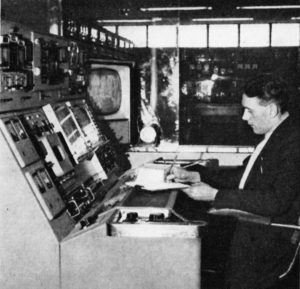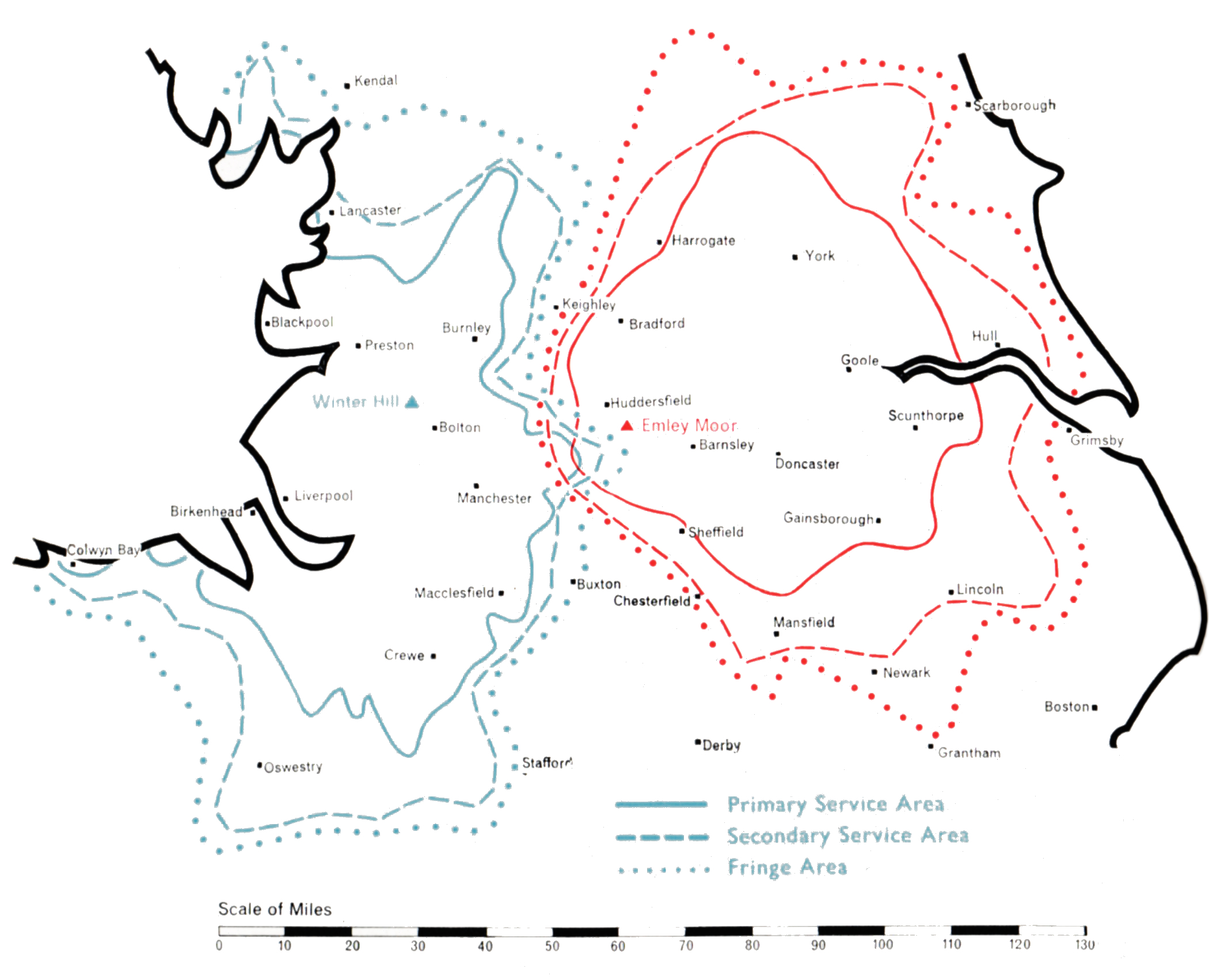- WINTER HILL
- Population within measured contours: Primary 6.43 mn, Secondary 0.53 mn, Fringe 0.63 mn. Total 7.59 mn.
- Channel: Band III Channel 9 (vertically polarised)
- Vision Carrier Frequency: Actual 194.75 Mc/s
- Sound Carrier Frequency: Actual 191.25 Mc/s
- Effective Radiated Power: Vision 100 kw. Sound 25 kw.
- Power of Transmitters: Vision (peak white) 10 kW. Sound (carrier) 2½ kW
- Heights above sea level: Site 1450 ft. Mean aerial 1,850 ft.
- Location: 2° 30′ 55″ W, 53° 37′ 35″ N.
- EMLEY MOOR
- Population within measured contours: Primary 3.36 mn, Secondary 0.995 mn, Fringe 0.555 mn. Total 4.91 mn.
- Channel: Band III Channel 10 (vertically polarised)
- Vision Carrier Frequency: Nominal 199.75 Mc/s. Actual 199.7372 Mc/s
- Sound Carrier Frequency: Nominal 196.25 Mc/s. Actual 196.2605 Mc/s
- Effective Radiated Power: Vision 200 kw maximum. Sound 50 kw maximum.
- Power of Transmitters: Vision (peak white) 10 kW. Sound (carrier) 2½ kW
- Heights above sea level: Site 850 ft. Mean aerial 1,250 ft.
- Location: 1° 39′ 45″ W, 53° 36′ 45″ N.
Winter Hill (Channel 9) and Emley Moor (Channel 10)
Companies: Granada TV Network (weekdays), A.B.C. Television (weekends)
The first proposal for covering the great Northern area with its population of about thirteen million was to build a high-power transmitting station close to the existing BBC Band I station at Holme Moss on the high central rib of the Pennine Chain. Studies showed that this would have been technically attractive had it been possible at that time, without a very considerable delay for special development, to provide an effective radiated power of about 500 kW with a mast height of at least 1,000 ft. Even so, severe fading would undoubtedly have been experienced at the fringes of the service area, on the west coast at Liverpool and on the east coast at Hull.
These and other considerations led the Authority to conclude that the area would be served best by two transmitting stations, one on the western slopes of the Pennines to serve Lancashire, Cheshire and parts of Staffordshire, and another on the east side of the Pennines to serve Yorkshire. The Postmaster-General agreed to this proposal, which constituted the first of several departures from the general principle that Band III stations should be sited close to existing Band I stations. The quality of service which has been given to the North of England as a result of this departure has fully justified the decision. Winter Hill, the Lancashire station, was constructed on the summit of Rivington Moor, a fine site 1,450 feet above sea level. The aerial, which is carried on a self-supporting 450 ft. tower radiates 100 kW omnidirectionadly. Construction work began in September 1955 and the station went into programme service on 3rd May 1956.

The selection of the site for the Yorkshire station posed considerable problems largely because coverage of the main concentration of population within the hill-shadowed towns of the West Riding had to be combined with the provision of a service as far away as Kingston-upon-Hull some 5o miles away across the Yorkshire Plain.
Sixteen different sites were studied theoretically and tests, using a balloon transmitter, were made at four of them before Emley Moor, 850 feet above sea level on the eastern slopes of the Pennine Chain, was finally selected. Once again, because of the small area available, a 450 ft. tower was used to support the aerial, which has a semicircular power-radiation pattern delivering 200 kW e.r.p. in all easterly directions but only a few kilowatts backwards to the west into the natural barrier of the Pennines, thus preventing waste and an unnecessary overlap with the service area of the Winter Hill station. Emley Moor went into service on 3rd November 1956.

